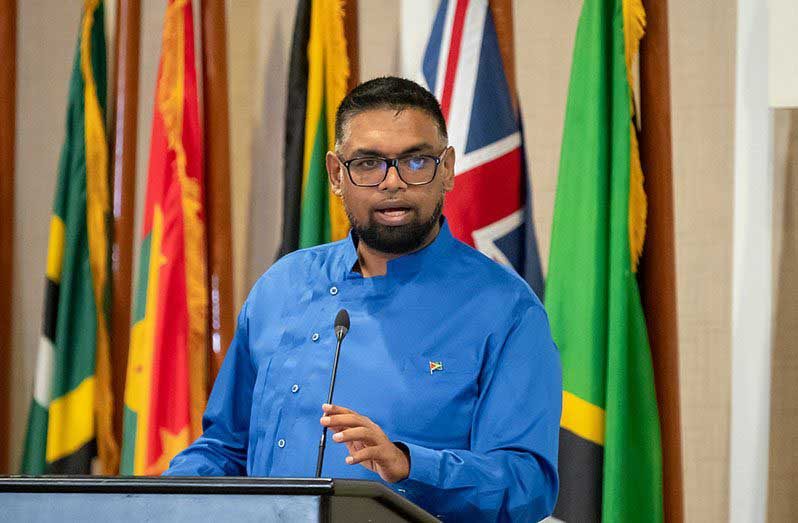-says significant opportunities will open up for local private sector
WITH chances of a more favourable climate for energy investments, Guyana is optimistic that there will be a greater appetite for financing energy projects.
In a recent engagement, Guyana’s President, Dr Irfaan Ali discussed the evolving landscape of energy projects, the opportunities for local and regional investments and the significant economic benefits that Guyana stands to gain through strategic partnerships and enhanced infrastructure.
“We hope that there will be greater appetite for lending for energy projects and the cost of that financing will be more manageable because the cost was ramping up.”
He pointed to a shift in policy under the new United States (U.S.) administration, which could potentially see financing for energy-related projects ramping up.
Just last month, Guyana and the US-EXIM bank officially inked a financing agreement for the country’s premier gas-to-energy (GTE) project.
Back in December, the financial institution granted its final approval for the US$526 million loan at their board meeting, after having completed the 35-day congressional notice period.
The benefits of this project go beyond cheaper electricity. It was highlighted that there could be additional revenue potential from gas liquids extracted during the process.
DOWNSTREAM OPPORTUNITIES
The Head of State further highlighted that the downstream sector presents significant opportunities for local private sector participation.
“In the downstream, I think there are some opportunities here, for a store, local private sector. We want to ensure that we can leverage to the maximum local capital, local private sector, local individuals,” he noted.
“We want to work on a strategy that maximises local capital, that brings together all the local capital in the market. And we have to work on a culture of working together, building consortiums, building, you know, corporations raising capital and then secondly, maximise [sic] regional liquidity.”
The President emphasised that the approach would begin with local investments, expand regionally and then look toward international partnerships with investors who bring expertise, technology and experience to the table. This approach, according to President Ali, would allow Guyana to not only meet its energy needs, but also ensure that the country reaps the full benefits of upstream and downstream economic activities.
“So, we have first local, then regional, creating that partnership and then to the international investors with the experience [and] expertise of technology, looking at their experience, technology and expertise, to partner with our local private sector to maximise the benefit[s] that will be coming upstream and downstream,” President Ali stated.
One of the key areas the President focused on was the potential of Guyana’s natural resources, particularly in the area of cooking gas.
He highlighted the significant impact the GTE could have on the local population, stating that the price of cooking gas could be lowered substantially.
“From Wales, government alone, we will— in layman’s terms—be able to lower significantly the price of cooking gas for the local population.”
This he said would save Guyana foreign currency from imports and open even wider opportunities for the country.
“Just imagine the transport and logistics infrastructure that have to be built across the country. And then we will have enough excess to go back into the region or even northern Brazil, where there is high demand, so creating new markets and new export and a new stream of foreign currency earning.”
President Ali also noted the importance of using Guyana’s gas resources to support other industries, particularly agriculture.
He spoke about plans to utilise remaining gas from a first project to establish a small fertiliser plant, which would help meet national demand and reduce the reliance on costly imports.
“Then we are of the view that will have just enough gas remaining on the first project for a small fertiliser plant. That could satisfy national demand. So that is an input cost now that will save all that US dollars that would go to agriculture.”
This, he emphasised, aligns with Guyana’s vision of becoming the breadbasket of the region and a major player in the global food industry.
“If you could subsidise or bring down the cost of fertilisers for the farmers, then we are incentivising agriculture production and that is linked to our vision of becoming the breadbasket of the region and a major player in the food industry.”
These initiatives he noted, reflect the government’s ongoing efforts to foster economic diversification, enhance local and regional collaboration and build sustainable infrastructure that can support both national and international demand.
With an eye on expanding opportunities across sectors, particularly in energy and agriculture, Guyana is poised to continue its path toward economic growth and development.




.jpg)










